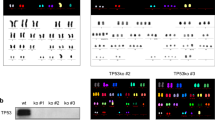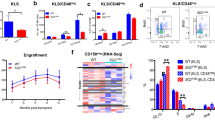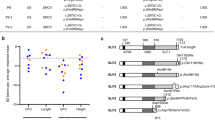Abstract
The identification of the genes associated with chromosomal translocation breakpoints has fundamentally changed understanding of the molecular basis of hematological malignancies. By contrast, the study of chromosomal deletions has been hampered by the large number of genes deleted and the complexity of their analysis. We report the generation of a mouse model for human 5q– syndrome using large-scale chromosomal engineering. Haploinsufficiency of the Cd74–Nid67 interval (containing Rps14, encoding the ribosomal protein S14) caused macrocytic anemia, prominent erythroid dysplasia and monolobulated megakaryocytes in the bone marrow. These effects were associated with defective bone marrow progenitor development, the appearance of bone marrow cells expressing high amounts of the tumor suppressor p53 and increased bone marrow cell apoptosis. Notably, intercrossing with p53-deficient mice completely rescued the progenitor cell defect, restoring common myeloid progenitor and megakaryocytic-erythroid progenitor, granulocyte-monocyte progenitor and hematopoietic stem cell bone marrow populations. This mouse model suggests that a p53-dependent mechanism underlies the pathophysiology of the 5q– syndrome.
This is a preview of subscription content, access via your institution
Access options
Subscribe to this journal
Receive 12 print issues and online access
$209.00 per year
only $17.42 per issue
Buy this article
- Purchase on Springer Link
- Instant access to full article PDF
Prices may be subject to local taxes which are calculated during checkout






Similar content being viewed by others
References
Van den Berghe, H. et al. Distinct hematological disorder with deletion of long arm of no. 5 chromosome. Nature 251, 437–438 (1974).
Giagounidis, A.A., Germing, U., Wainscoat, J.S., Boultwood, J. & Aul, C. The 5q– syndrome. Hematology 9, 271–277 (2004).
List, A. et al. Lenalidomide in the myelodysplastic syndrome with chromosome 5q deletion. N. Engl. J. Med. 355, 1456–1465 (2006).
Vardiman, J.W., Harris, N.L. & Brunning, R.D. The World Health Organization (WHO) classification of the myeloid neoplasms. Blood 100, 2292–2302 (2002).
Boultwood, J., Lewis, S. & Wainscoat, J.S. The 5q– syndrome. Blood 84, 3253–3260 (1994).
Le Beau, M.M. et al. Cytogenetic and molecular delineation of the smallest commonly deleted region of chromosome 5 in malignant myeloid diseases. Proc. Natl. Acad. Sci. USA 90, 5484–5488 (1993).
Boultwood, J. et al. Molecular mapping of uncharacteristically small 5q deletions in two patients with the 5q– syndrome: delineation of the critical region on 5q and identification of a 5q– breakpoint. Genomics 19, 425–432 (1994).
Boultwood, J. et al. Narrowing and genomic annotation of the commonly deleted region of the 5q– syndrome. Blood 99, 4638–4641 (2002).
Lai, F. et al. Transcript map and comparative analysis of the 1.5-Mb commonly deleted segment of human 5q31 in malignant myeloid diseases with a del(5q). Genomics 71, 235–245 (2001).
Boultwood, J. et al. Gene expression profiling of CD34+ cells in patients with the 5q– syndrome. Br. J. Haematol. 139, 578–589 (2007).
Soengas, M.S. et al. Inactivation of the apoptosis effector Apaf-1 in malignant melanoma. Nature 409, 207–211 (2001).
Teitz, T. et al. Caspase 8 is deleted or silenced preferentially in childhood neuroblastomas with amplification of MYCN. Nat. Med. 6, 529–535 (2000).
Brekken, R.A. & Sage, E.H. SPARC, a matricellular protein: at the crossroads of cell-matrix. Matrix Biol. 19, 569–580 (2000).
Lehmann, S. et al. Common deleted genes in the 5q– syndrome: thrombocytopenia and reduced erythroid colony formation in SPARC null mice. Leukemia 21, 1931–1936 (2007).
Ebert, B.L. et al. Identification of RPS14 as a 5q– syndrome gene by RNA interference screen. Nature 451, 335–339 (2008).
Draptchinskaia, N. et al. The gene encoding ribosomal protein S19 is mutated in Diamond-Blackfan anemia. Nat. Genet. 21, 169–175 (1999).
Bagchi, A. et al. CHD5 is a tumor suppressor at human 1p36. Cell 128, 459–475 (2007).
Zhu, Y. et al. Genomic interval engineering of mice identifies a novel modulator of triglyceride production. Proc. Natl. Acad. Sci. USA 97, 1137–1142 (2000).
LePage, D.F., Church, D.M., Millie, E., Hassold, T.J. & Conlon, R.A. Rapid generation of nested chromosomal deletions on mouse chromosome 2. Proc. Natl. Acad. Sci. USA 97, 10471–10476 (2000).
Dixon, J., Brakebusch, C., Fassler, R. & Dixon, M.J. Increased levels of apoptosis in the prefusion neural folds underlie the craniofacial disorder, Treacher Collins syndrome. Hum. Mol. Genet. 9, 1473–1480 (2000).
Forster, A. et al. Engineering de novo reciprocal chromosomal translocations associated with Mll to replicate primary events of human cancer. Cancer Cell 3, 449–458 (2003).
Grobe, K. et al. Cerebral hypoplasia and craniofacial defects in mice lacking heparan sulfate Ndst1 gene function. Development 132, 3777–3786 (2005).
Bikoff, E.K. et al. Defective major histocompatibility complex class II assembly, transport, peptide acquisition and CD4+ T cell selection in mice lacking invariant chain expression. J. Exp. Med. 177, 1699–1712 (1993).
Jones, N.C. et al. Prevention of the neurocristopathy Treacher Collins syndrome through inhibition of p53 function. Nat. Med. 14, 125–133 (2008).
McGowan, K.A. et al. Ribosomal mutations cause p53-mediated dark skin and pleiotropic effects. Nat. Genet. 40, 963–970 (2008).
Panić, L. et al. Ribosomal protein S6 gene haploinsufficiency is associated with activation of a p53-dependent checkpoint during gastrulation. Mol. Cell. Biol. 26, 8880–8891 (2006).
Warner, J.R. & McIntosh, K.B. How common are extraribosomal functions of ribosomal proteins? Mol. Cell 34, 3–11 (2009).
Danilova, N., Sakamoto, K.M. & Lin, S. p53 family in development. Mech. Dev. 125, 919–931 (2008).
Kiel, M.J. et al. SLAM family receptors distinguish hematopoietic stem and progenitor cells and reveal endothelial niches for stem cells. Cell 121, 1109–1121 (2005).
Loonstra, A. et al. Growth inhibition and DNA damage induced by Cre recombinase in mammalian cells. Proc. Natl. Acad. Sci. USA 98, 9209–9214 (2001).
Pellagatti, A. et al. Haploinsufficiency of RPS14 in 5q– syndrome is associated with deregulation of ribosomal- and translation-related genes. Br. J. Haematol. 142, 57–64 (2008).
Ferreira-Cerca, S., Poll, G., Gleizes, P.E., Tschochner, H. & Milkereit, P. Roles of eukaryotic ribosomal proteins in maturation and transport of pre-18S rRNA and ribosome function. Mol. Cell 20, 263–275 (2005).
Jakovljevic, J. et al. The carboxy-terminal extension of yeast ribosomal protein S14 is necessary for maturation of 43S preribosomes. Mol. Cell 14, 331–342 (2004).
Dokal, I. & Vulliamy, T. Inherited aplastic anemias/bone marrow failure syndromes. Blood Rev. 22, 141–153 (2008).
Gazda, H.T. et al. Ribosomal protein S24 gene is mutated in Diamond-Blackfan anemia. Am. J. Hum. Genet. 79, 1110–1118 (2006).
Janov, A.J., Leong, T., Nathan, D.G. & Guinan, E.C. Diamond-Blackfan anemia. Natural history and sequelae of treatment. Medicine (Baltimore) 75, 77–78 (1996).
Menne, T.F. et al. The Shwachman-Bodian-Diamond syndrome protein mediates translational activation of ribosomes in yeast. Nat. Genet. 39, 486–495 (2007).
Sulic, S. et al. Inactivation of S6 ribosomal protein gene in T lymphocytes activates a p53-dependent checkpoint response. Genes Dev. 19, 3070–3082 (2005).
Danilova, N., Sakamoto, K.M. & Lin, S. Ribosomal protein S19 deficiency in zebrafish leads to developmental abnormalities and defective erythropoiesis through activation of p53 protein family. Blood 112, 5228–5237 (2008).
Valdez, B.C., Henning, D., So, R.B., Dixon, J. & Dixon, M.J. The Treacher Collins syndrome (TCOF1) gene product is involved in ribosomal DNA gene transcription by interacting with upstream binding factor. Proc. Natl. Acad. Sci. USA 101, 10709–10714 (2004).
Gonzales, B. et al. The Treacher Collins syndrome (TCOF1) gene product is involved in pre-rRNA methylation. Hum. Mol. Genet. 14, 2035–2043 (2005).
Dixon, J. et al. Tcof1/Treacle is required for neural crest cell formation and proliferation deficiencies that cause craniofacial abnormalities. Proc. Natl. Acad. Sci. USA 103, 13403–13408 (2006).
Fumagalli, S. et al. Absence of nucleolar disruption after impairment of 40S ribosome biogenesis reveals an rpL11-translation–dependent mechanism of p53 induction. Nat. Cell Biol. 11, 501–508 (2009).
Patel, S.R. et al. Differential roles of microtubule assembly and sliding in proplatelet formation by megakaryocytes. Blood 106, 4076–4085 (2005).
Montaville, P. et al. Nuclear translocation of the calcium-binding protein ALG-2 induced by the RNA-binding protein RBM22. Biochim. Biophys. Acta 1763, 1335–1343 (2006).
Venables, J.P. Aberrant and alternative splicing in cancer. Cancer Res. 64, 7647–7654 (2004).
Deller, T. et al. Synaptopodin-deficient mice lack a spine apparatus and show deficits in synaptic plasticity. Proc. Natl. Acad. Sci. USA 100, 10494–10499 (2003).
Vician, L., Silver, A.L., Farias-Eisner, R. & Herschman, H.R. NID67, a small putative membrane protein, is preferentially induced by NGF in PC12 pheochromocytoma cells. J. Neurosci. Res. 64, 108–120 (2001).
Donehower, L.A. et al. Mice deficient for p53 are developmentally normal but susceptible to spontaneous tumours. Nature 356, 215–221 (1992).
Acknowledgements
Thanks go to members of the McKenzie lab for their comments on the manuscript. We are grateful to the Laboratory of Molecular Biology animal facility staff, especially V. Smith. We are also grateful to K. Grobe (University of Munster) for providing blood from the Ndst1+/− mice and T. Rabbitts (Leeds Institute of Molecular Medicine) for providing Lmo2Cre mice. A.N.J.M., D.R.H., S.L.-A., A.L.L., J.S.W., J.B. and A.J.W. were funded by Leukaemia Research UK.
Author information
Authors and Affiliations
Contributions
A.N.J.M. conceived of and designed the project; A.N.J.M., D.R.H., L.R.H., A.L.L., L.F.D., R.P. and H.E.J. designed and generated gene-targeted mice; A.N.J.M., J.L.B., L.F.D., S.L.-A., A.L.L., A.J.M., J.B., S.H.W., J.S.W. and A.J.W. analyzed hematopoiesis; J.S.W. and J.B. performed gene expression profiling analysis and provided unpublished information; H.E.J. performed annexin V analysis. All authors contributed to the writing of the paper.
Corresponding author
Supplementary information
Supplementary Text and Figures
Supplementary Figures 1–8 and Supplementary Methods (PDF 4405 kb)
Rights and permissions
About this article
Cite this article
Barlow, J., Drynan, L., Hewett, D. et al. A p53-dependent mechanism underlies macrocytic anemia in a mouse model of human 5q– syndrome. Nat Med 16, 59–66 (2010). https://doi.org/10.1038/nm.2063
Received:
Accepted:
Published:
Issue Date:
DOI: https://doi.org/10.1038/nm.2063
This article is cited by
-
Decoding the pathogenesis of Diamond–Blackfan anemia using single-cell RNA-seq
Cell Discovery (2022)
-
PRC2 insufficiency causes p53-dependent dyserythropoiesis in myelodysplastic syndrome
Leukemia (2021)
-
The regulatory roles of p53 in cardiovascular health and disease
Cellular and Molecular Life Sciences (2021)
-
Ribosome assembly coming into focus
Nature Reviews Molecular Cell Biology (2019)
-
Heterogeneity and specialized functions of translation machinery: from genes to organisms
Nature Reviews Genetics (2018)



